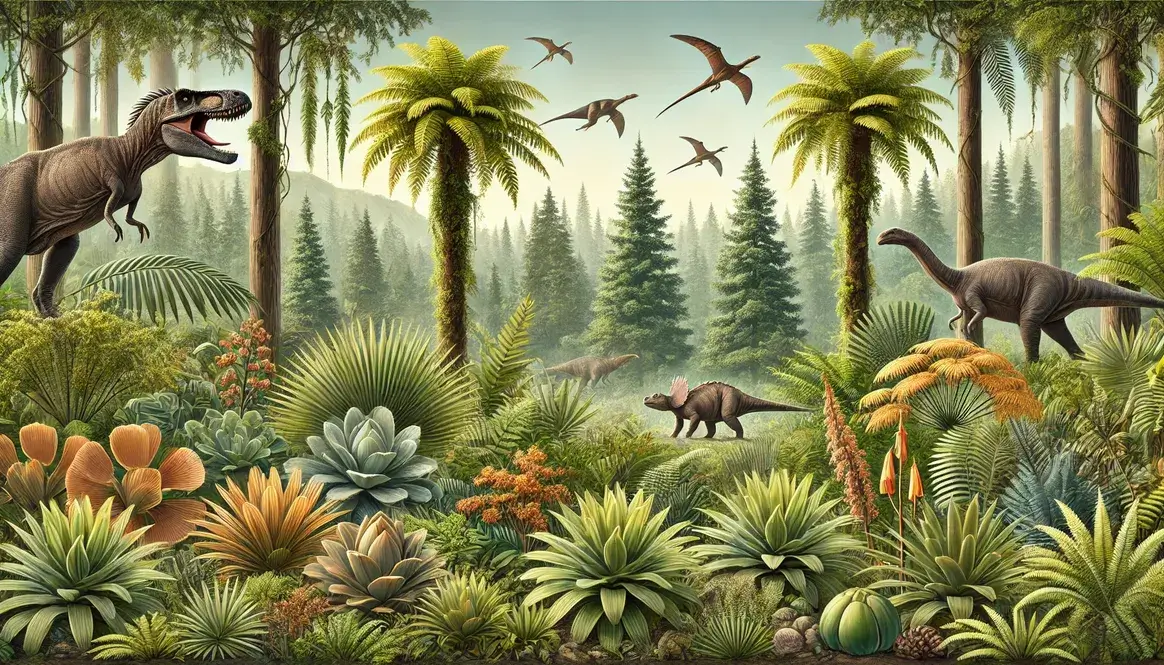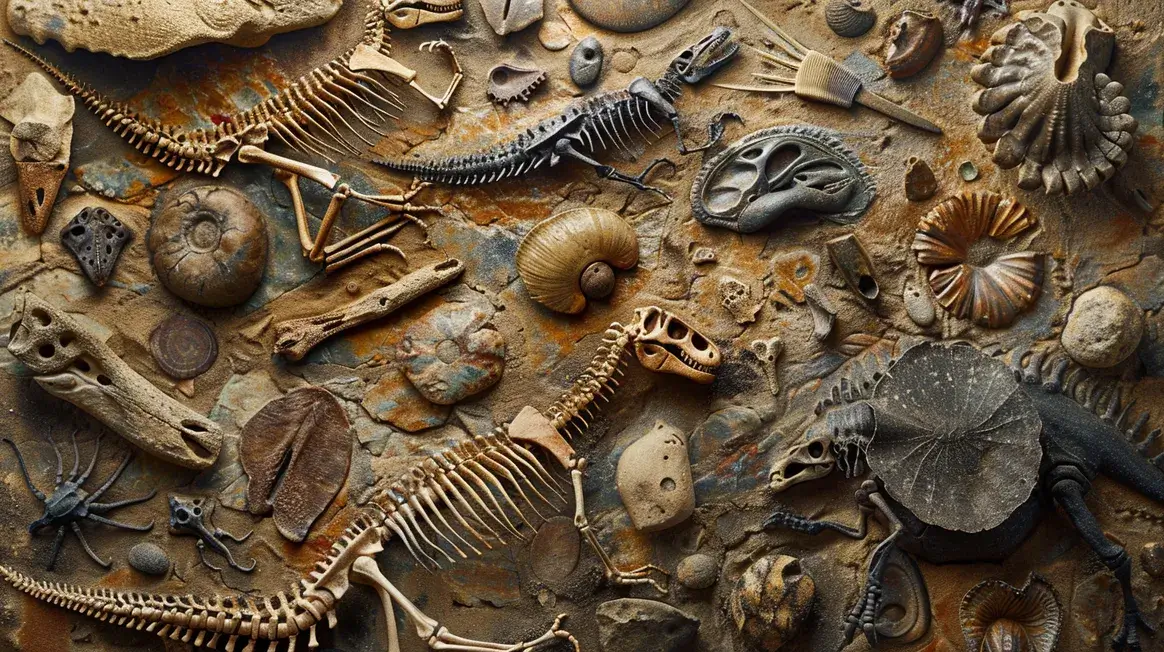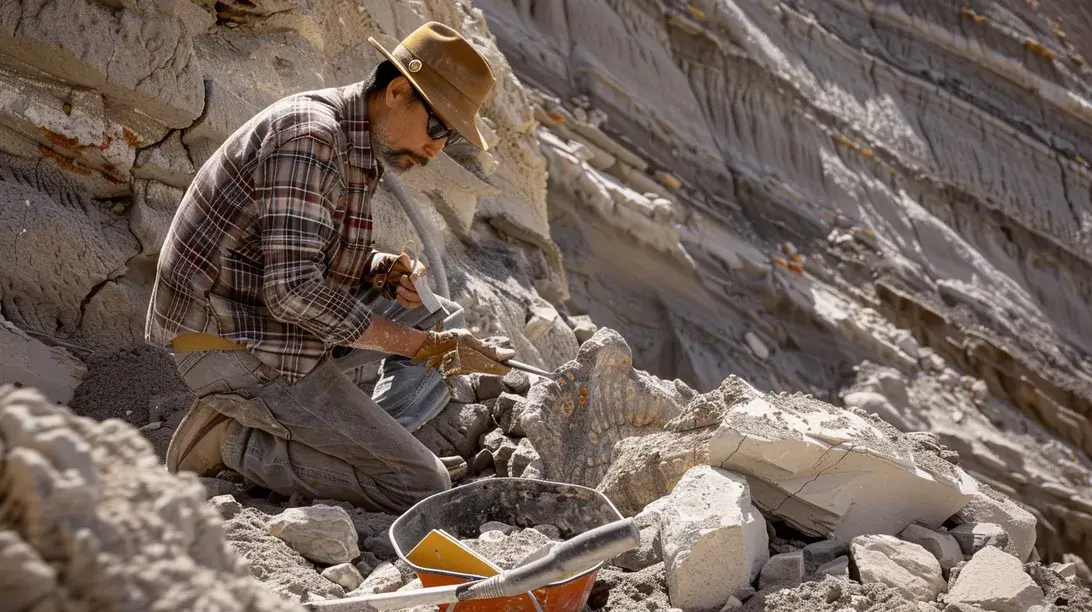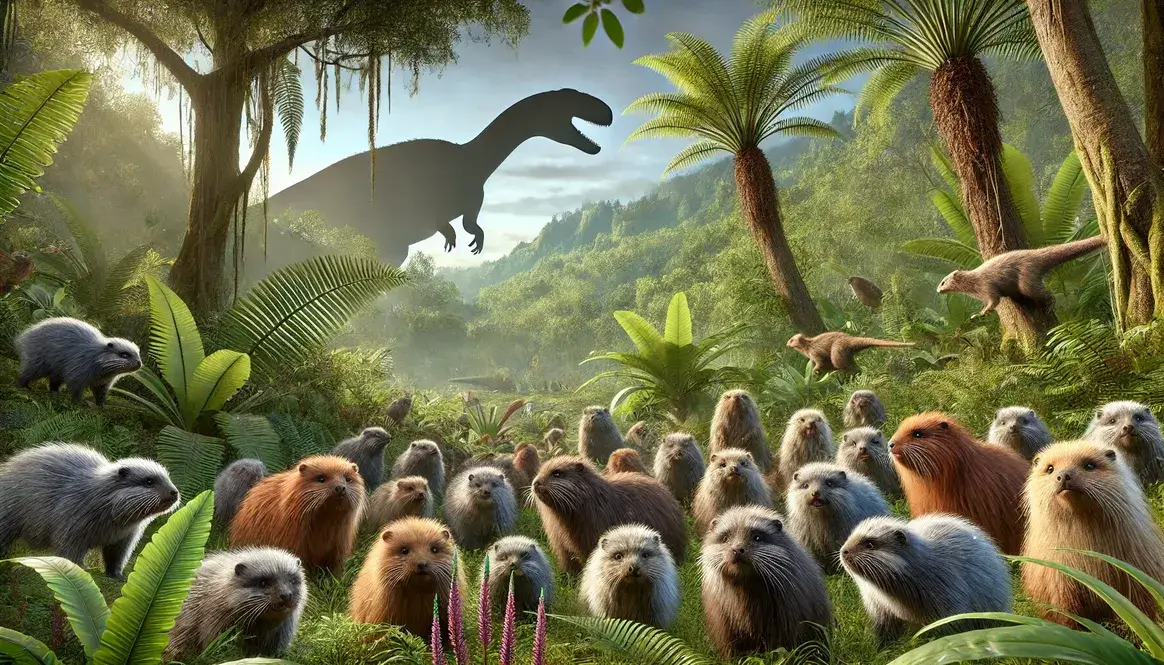Let’s take a journey back in time, about 201 to 145 million years ago, to an era when dinosaurs roamed the Earth and lush greenery covered the landscape. Welcome to the world of Jurassic plants, a fascinating chapter in Earth’s botanical history!
The Jurassic Landscape: A Green Revolution
The Jurassic period was a time of significant change and growth for plant life. Picture a world much warmer and more humid than today, with no ice caps at the poles. This climate created perfect conditions for plants to thrive and diversify.
Jurassic plants played a crucial role in shaping the ecosystems of their time. They provided:
- Food for herbivorous dinosaurs
- Shelter for smaller creatures
- Oxygen for the atmosphere
- Stability for soil and water systems
These green giants supported the massive sauropods browsing on treetops and the smaller creatures scurrying about the forest floor.
Jurassic Plants: Dominant Flora of the Age
During the Jurassic, several plant groups dominated the landscape. Let’s explore these green giants of the past!
Gymnosperms: The Naked Seed Plants
Gymnosperms were the superstars of Jurassic plants. But what exactly are they? The term “gymnosperm” comes from Greek, meaning “naked seeds.” Unlike flowering plants, gymnosperms produce seeds that aren’t enclosed in an ovary.
These plants were everywhere in Jurassic ecosystems, from towering forests to low-lying scrublands. They were the main food source for many plant-eating dinosaurs and played a big part in the Jurassic food web.
Cycads: Living Fossils of the Jurassic
Cycads might look like palm trees, but they’re actually more closely related to pines! These fascinating plants have:
- A thick, sturdy trunk
- A crown of large, feather-like leaves
- Seed cones instead of flowers
During the Jurassic, cycads were incredibly diverse and widespread. They could be found in many different habitats, from coastal areas to inland forests. Some scientists call cycads “living fossils” because modern cycads look very similar to their Jurassic ancestors!
Conifers: Evergreen Giants
Conifers, like modern pine and fir trees, were also major players in Jurassic forests. These evergreen trees had needle-like leaves and produced cones instead of flowers.
Jurassic conifers came in many shapes and sizes:
- Tall, straight trees perfect for pterosaurs to perch on
- Spreading trees that provided shade for smaller creatures
- Shrub-like forms that covered the ground in some areas
Ginkgoes: Ancient Survivors
Believe it or not, the ginkgo trees we see in parks and streets today have hardly changed since the Jurassic period! These “living fossils” have distinctive fan-shaped leaves that make them easy to recognize.
Ginkgoes were important members of Jurassic forests. Their tough leaves could withstand harsh conditions, helping them survive when other plants couldn’t.
Ferns and Horsetails: Understory Plants
While big trees dominated the canopy, ferns and horsetails thrived in the understory. Ferns in the Jurassic were incredibly diverse, ranging from small ground-cover plants to tree-like forms.
Horsetails, relatives of modern scouring rushes, were also common. These plants have:
- Jointed stems
- Small, scale-like leaves
- The ability to reproduce through spores
They often grew in wet areas, helping to stabilize soil near water sources.
Evolution of Jurassic Flora
The Jurassic period was a time of great change for plant life. As the climate shifted and new habitats opened up, plants evolved to take advantage of these new opportunities. This led to an explosion of diversity in Jurassic plants.
From Triassic to Jurassic: Plant Transitions
The shift from the Triassic to the Jurassic period wasn’t smooth sailing for plant life. The Triassic-Jurassic extinction event wiped out many plant species, but it also created opportunities for survivors to evolve and diversify.
Key changes in plant life during this transition included:
- Decline of seed ferns: Once dominant, these plants became less common
- Rise of cycads and ginkgoes: These groups expanded and diversified
- Emergence of new conifer families: Including ancestors of modern pines and cypresses
As the Jurassic progressed, new plant groups emerged. The gymnosperm-dominated landscapes became more diverse, setting the stage for the later evolution of flowering plants.
Adaptive Radiation of Gymnosperms
Gymnosperms underwent an impressive adaptive radiation during the Jurassic. This means they evolved into many different forms to fill various ecological niches.
Several factors drove this diversification:
- Climate changes
- New habitats opening up
- Coevolution with insects and other animals
Some newly evolved plant species included different types of conifers adapted to specific climates, and cycads with various leaf shapes for different light conditions.
| Plant Group | Key Characteristics | Ecological Role |
|---|---|---|
| Gymnosperms | Naked seeds, no flowers | Dominant plant group, main food source for herbivores |
| Cycads | Palm-like appearance, thick trunks | Widespread, adapted to various habitats |
| Conifers | Needle-like leaves, produce cones | Formed large forests, provided shelter for animals |
| Ginkgoes | Fan-shaped leaves | Resilient, survived in harsh conditions |
| Ferns and Horsetails | Reproduce via spores | Understory plants, soil stabilizers |
This diverse plant life created the lush, green world of the Jurassic, supporting a wide array of animal life and shaping the face of the planet for millions of years to come.
Jurassic Plant Adaptations
As the Jurassic world changed, plants evolved clever ways to thrive in their new environments. Let’s explore how these green survivors adapted to the challenges of their time.
Climate Adaptations
The Jurassic period was generally warm and humid, but conditions varied across the globe. Plants developed various strategies to cope with these diverse climates. Many Jurassic plants evolved waxy leaf coatings to reduce water loss in hot conditions, while others developed thick, fleshy leaves to store water, similar to modern succulents.
In some regions, plants faced periodic droughts. These tougher environments led to the evolution of drought-resistant features:
- Smaller leaves to reduce water loss
- Ability to shed leaves during dry seasons
- Seeds that could remain dormant until conditions improved
Structural Adaptations
Jurassic plants also underwent significant structural changes to make the most of their environment. Leaf structures varied widely, from broad, flat leaves in humid forests to needle-like leaves in drier areas. Some plants even developed vertically oriented leaves to avoid intense midday sun.
Stem and root modifications were equally diverse:
- Hollow stems in some plants for efficient nutrient transport
- Aerial roots in tropical species to absorb moisture from the air
- Thick bark in some trees for protection against forest fires
Reproductive Adaptations
The Jurassic saw major advancements in plant reproduction strategies. Seed dispersal mechanisms became more sophisticated, with some plants developing wind-dispersed seeds with wings or parachute-like structures. Others produced tough seed coats to protect against the digestive systems of herbivores, while some developed fleshy fruits to attract animals for seed dispersal.
Pollination strategies also evolved. Conifers developed complex cone structures for wind pollination, while other plants began producing scented resins to attract early pollinating insects. These adaptations allowed Jurassic plants to spread more efficiently and colonize new areas.
Jurassic Plant Ecology
The ecology of Jurassic plants was complex and varied, creating diverse landscapes across the planet.
Forest Structures
Jurassic forests were quite different from modern ones. They typically consisted of a canopy layer of tall conifers and ginkgoes, an understory of smaller trees and large ferns, and a ground cover of ferns, horsetails, and small cycads.
This structure created various niches for different plant species and the animals that depended on them. For example, some small, early mammals might have lived in the understory, while larger dinosaurs browsed in the canopy.
Plant-Animal Interactions
The relationship between Jurassic plants and animals was a two-way street. Plants developed tough leaves and spines to deter browsers, while some grew taller to escape ground-dwelling herbivores. Certain plant species may have even evolved toxins as a defense mechanism.
Early insect pollination relationships also began to form during this time. Some plants produced scented resins to attract insects, and early flowers may have begun to evolve, attracting primitive moths and beetles. This relationship laid the groundwork for the later explosion of flowering plants.
Jurassic Plant Communities
Jurassic plant communities varied widely depending on location and climate:
| Climate Zone | Dominant Plants | Characteristics |
|---|---|---|
| Tropical | Cycads, tree ferns | Dense, multi-layered forests |
| Temperate | Conifers, ginkgoes | Open woodlands with diverse understory |
| Arid | Drought-resistant conifers | Sparse vegetation, adapted to water scarcity |
These communities weren’t static. They changed over time through a process called succession, where pioneer species colonized new areas, gradually larger plants established themselves, and eventually, a mature forest ecosystem developed.
This dynamic process ensured that Jurassic landscapes were always changing, providing new opportunities for both plants and animals to evolve and adapt. The diverse plant communities of the Jurassic created the backdrop for the dramatic events of this fascinating period in Earth’s history.
Importance of Plants in Jurassic Ecosystems
Jurassic plants were more than just scenery for dinosaurs. They played crucial roles in shaping and maintaining the ecosystems of their time.
Primary Production and Food Webs
At the base of every Jurassic food chain stood the mighty plants. They converted sunlight into energy, providing the foundation for all animal life. From the tiniest insects to the largest sauropods, every creature relied on plants either directly or indirectly.
Consider this: A single large sauropod might eat over a ton of plant matter daily! To support such massive herbivores, Jurassic plants had to be incredibly productive. This abundance of plant life allowed for a diverse array of plant-eating animals, which in turn supported various carnivores.
Habitat Creation
Jurassic plants didn’t just feed animals; they created entire worlds for them to live in. Towering conifers and spreading ginkgoes formed canopies that:
- Provided shelter from harsh sunlight
- Created cooler, moister microclimates beneath
- Offered nesting sites for flying creatures
On the forest floor, ferns and cycads created hiding spots for smaller animals and hunting grounds for predators. Even dead plants played a role, with fallen logs becoming homes for insects and small vertebrates.
Climate Regulation
Just like modern plants, Jurassic flora played a big part in regulating Earth’s climate. They absorbed carbon dioxide through photosynthesis, helping to control greenhouse gas levels. This process had far-reaching effects:
- Oxygen production for animal life
- Carbon storage in plant tissues and soil
- Influence on local weather patterns through transpiration
Large Jurassic forests likely created their own microclimates, influencing rainfall and temperature patterns on a regional scale.
Studying Jurassic Plants: Windows to the Past
How do we know so much about plants that lived over 145 million years ago? Scientists use a variety of clever methods to piece together the puzzle of Jurassic flora.
Fossil Evidence: The most direct way to study Jurassic plants is through their fossils. These can take many forms:
- Petrified wood, where the original plant material is replaced by minerals
- Leaf impressions in rock, showing the shapes and vein patterns of ancient leaves
- Preserved pollen and spores, which can tell us about plant types and distributions
Chemical Analysis: By studying the chemical composition of Jurassic rocks and fossils, scientists can learn about ancient atmospheres and climates, giving clues about the plants that lived then.
Comparative Studies: Modern plants related to Jurassic species can provide insights into how their ancient ancestors might have lived and functioned.
These plant fossils are invaluable for understanding Jurassic ecosystems. They tell us about:
- The types of plants that existed
- The climates they lived in
- How they interacted with animals
By studying plant fossils alongside animal remains, scientists can reconstruct entire Jurassic ecosystems, painting a vivid picture of life in the age of dinosaurs.
Legacy of Jurassic Plants
The green giants of the Jurassic may be long gone, but their legacy lives on in many ways.
Modern Descendants
Some plant groups that thrived in the Jurassic are still with us today:
| Jurassic Plant Group | Modern Descendants | Notable Features |
|---|---|---|
| Ginkgoes | Ginkgo biloba | Virtually unchanged since the Jurassic |
| Cycads | Various cycad species | Still found in tropical and subtropical regions |
| Conifers | Pines, firs, redwoods | Dominant in many modern forest ecosystems |
These “living fossils” provide a direct link to the Jurassic world, allowing scientists to study plants similar to those that dinosaurs once browsed.
Lessons for Modern Biodiversity
The story of Jurassic plants offers valuable insights for understanding and preserving modern biodiversity:
- Adaptability: Jurassic plants show how species can adapt to changing environments over time.
- Interconnectedness: The complex relationships between Jurassic plants and animals remind us of the importance of preserving entire ecosystems, not just individual species.
- Resilience: Some plant groups survived multiple mass extinctions, demonstrating the resilience of life on Earth.
By studying how Jurassic plants responded to changes in their world, we can better understand how modern plants might react to current climate changes. This knowledge is crucial for conservation efforts and predicting future ecological shifts.









